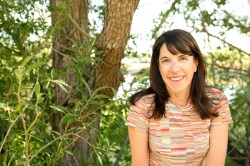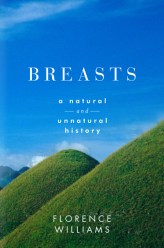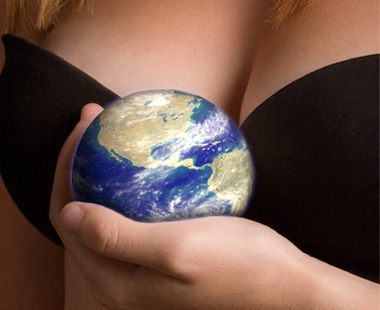
Photo by Corrynn Cochran.
Florence Williams is a decorated environmental writer, one of my personal heroes (we launched our careers at the same ragtag Western environmental mag), and author of the new book Breasts: A Natural and Unnatural History. I caught up with her over a cup of coffee this week and learned a little about the biological theories of bustiness, the chemical cocktails that are showing up in breast milk, and a smartphone app that makes my childhood days of sneaking peeks at Playboy bunnies look positively pedestrian.
Q. Why write a book about breasts?
A. The idea occurred to me when I was breastfeeding. I hadn’t really thought about my breasts before that, but suddenly, I was totally wowed by them and what they were able to do. It’s totally amazing. And then of course I learned that there were toxins in breast milk, and so that really launched me down this path of trying to learn how modern life has changed breasts and how breasts evolved and why they’re so special to us to begin with.
Q. Why are human breasts so different from other mammals’?
A. This turns out to be much more controversial than I expected. The dominant theory is that breasts must be sexual signals. They must have evolved to give mates information — for example, fertility status, youth, health. In other words, they evolved for men.
Q. You’re not convinced?
A. We know that they’re mostly made up of fat, and we know that they’re filled with estrogen and progesterone receptors. So is there something about that that gave us an advantage as a species, when we were evolving? It turns out that the human female does need more fat in order to even reach puberty, and then in order to gestate and lactate. And the human infant needs more fat than any other primate infant. Our brains are five times bigger.
Q. So we need more fat — more breast milk — to feed our giant brains.
A. It’s all about the brains. And it’s also about the birth canal, actually. Because our babies had to be really small — the heads had to be really small to get out of this newly bipedal female skeleton. And so we had to be able to produce lots and lots of fatty milk for a long period of time, because these infants were so vulnerable and dependent for so long.
So really breasts evolved for women, and they evolved for infants.
 Q. But now there’s this issue of toxins in breast milk.
Q. But now there’s this issue of toxins in breast milk.
A. The breast, in some ways, is a catchment for our environmental trespasses, because it absorbs more industrial toxins than other parts of the body. It’s also really vulnerable to modern life and lifestyle changes. The breast tissue changes depending on what women are eating, and depending on what pharmaceuticals they’re taking — birth control pills, hormone replacement therapy — all these things change breast tissue.
Q. If you were to have another child would you breastfeed?
A. Yes, I definitely would. Breast milk is the only food on the planet that’s designed to help humans. There’s been so much research on things like red wine — give me a break, that’s so overblown. If you really want to know what food is supposed to help us metabolize and digest and build our immune system, go get yourself a breast.
Q. Can you detoxify your breast milk?
A. I tried it, and it’s next to impossible. We just don’t know where all of our exposures are coming from. So what it made me realize is that, really, the responsibility lies upstream, with manufacturers, with the government. Why are we making products with endocrine-disrupting compounds in the first place? If something good comes out of this book, I would hope that it helps politicize moms and parents to demand better testing of these chemicals and smarter use of substances.
Q. Are there any products that you won’t use now?
A. I really try to avoid very smelly personal care products. For example, things like room fresheners and toilet deodorizers — these things just make me nuts. Consumer culture tries so hard to convince us that we need to cleanse our homes with these really toxic products. So ironically, the cleaner we are, by consumer standards, the more polluted we become.
 Q. What was the most surprising thing you learned?
Q. What was the most surprising thing you learned?
A. It kind of surprises me how many women are interested in implants. We know that implants have a lot of side effects — they have a short shelf life, they harden up, sometimes they leak, sometimes they look funny, they sometimes cut off sensation in the nipple. But despite these problems, a remarkable number of women say they’re happy with these implants. That tells me that we still have a lot of work to do as parents and as a society to instill other avenues of achievement and self-esteem in our girls. And I think it’s more challenging now than ever, because there’s so much pornography now on the internet, there’s so many images of altered and fake, Photoshopped breasts out there that our children are growing up assuming as the standard.
Q. Has that improved at all? In the 1980s, porn stars had these gigantic, unnatural breasts.
A. It’s worse now, because in the ’80s we had a few magazines we looked at, and now our kids look at thousands and thousands — the statistics on this are really incredible — there are apps that 12-year-olds are downloading that are literally about 1,200 boobs. So they can download 1,200 boobs and there they have ’em, and most of those boobs are fake.
Q. You’ve just ruined my whole sense of what’s good and true in the world.
A. To write the chapter of the book about breast implants, I visited Houston, which is ground zero for implants, and I learned that one of the most successful implant surgeons in Houston actually had a swimming pool with a Jacuzzi in the middle of it, and it was supposed to look like a breast. The Jacuzzi was the nipple. And he earned millions. You think of Houston as this hardened oil derrick city, but it’s a city that’s built up around breasts.
Q. What’s the take-home message from this book?
A. The human body is really more permeable than we thought, and breasts are just one obvious and visible and in some ways fun example, but all the organs in our bodies are sensitive to environmental change. And breasts in some ways are just a metaphor for environmental health in general. So I think if we can try to take care of our breasts we will also be taking care of our bodies and also be taking care of the planet, because we now know that those things are interconnected. We’re not going to be able to take care of our bodies unless we take care of our environment.

